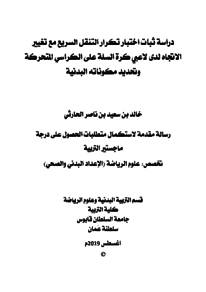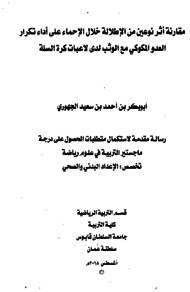Document
دراسة ثبات اختبار تكرار التنقل السريع مع تغيير الاتجاه لدى لاعبي كرة السلة على الكراسة المتحركة وتحديد مكوناته البدنية
Publisher
جامعة السلطان قابوس
Gregorian
2019
Language
Arabic
Subject
English abstract
The aim of this study was to examine the reliability of change of direction repeated sprint test (CDRS) in wheelchair basketball players and to determine its physical components. Descriptive approach was used. 14 wheelchair basketball players (age: 35+6.08 years, trunk length: 74.435.49 cm, weight: 64.21:15.54 kg) volunteered to participate in this study. All participants performed 6x20m with changes of direction (30s recovery in between) twice with at least 48 rest. CDRS performance indices were expressed as total time (TT), best time (BT) and fatigue index (FI). They also performed hand grip test, 20m straight sprint (5m acceleration and 15m maximal speed were recorded) and medicine ball throw (3kg). Results showed that the TT and BT were reliable (ICC = 0.988, CV = 2.6%; ICC = 0.97, CV = 2.68, respectively). Limits of agreement of TT and BT were 3.6s and 0.62s, respectively. In addition, significant correlations were observed between both TT and BT and 5m (0.550, 0.456, respectively), 15m (0.635, 0.599, respectively) and 20m (0.638, 0.614, respectively). However, no significant relationship was observed between both TT and BT and hand grip and the medicine ball throw tests. These results are very important for physical conditioning professionals and coaches to assess change of direction repeated sprint ability and to select the appropriate training programs to develop this ability. The results of the study also showed that there is no relationship between the indicators of repeated sprint with change of direction with each of hand grip and throwing the medicine ball.
In conclusion, the repeated sprint with change of direction test was reliability, and that the 5-15-20 m sprint test is a physical component of the proposed test. The researcher recommended conducting further research to ascertain construct validity and using the test extensively to determine the standard contents of the test.
Member of
Resource URL
Arabic abstract
الهدف من البحث هو دراسة ثبات اختبار تكرار التنقل السريع مع تغيير الاتجاه لدى لاعبي كرة السلة على الكراسي المتحركة وتحديد مكوناته البدنية. استخدم الباحث المنهج الوصفي. شارك في الدراسة 14 لاعب كرة سلة على الكراسي المتحركة ( العمر التقويمي : 35+6.08 سنة، طول الجذع :74.43 + 5.49 سم، الوزن : 64.21 +15.54 كغم). قام المشاركون باختبار 6*20 م مع تغيير الاتجاه تتخللها راحة 30 ثانية مرتين بينهما راحة 48 ساعة على الأقل وسجلت المؤشرات التالية: الزمن الكلي وأفضل زمن ومؤشر التعب. كما قام المشاركون باختبارات قوة القبضة والتنقل السريع 5 م و15م و20م رمي الكرة الطبية (3 كلغ). أظهرت النتائج أن مؤشر الزمن الكلى ومؤشر أفضل زمن يتمتعان بثبات عالي ( 0. 988=CV = 2 . 68 , ICC = 0 . 97 ; CV = 2 . 6 % , ICC، تباعا). كما أظهرت أشكال بلاند والتمان حدود توافق3.6 ثانية لمؤشر الزمن الكلي 0.62 ثانية لمؤشر أفضل زمن. غير أن مؤشر التعب لم يكن ثابتة لا على المستوى النسبي أو المطلق. وأوضحت النتائج وجود علاقة ذات دلالة إحصائية >p ( 0 . 05) بين الزمن الكلي وأفضل زمن وكل من زمن التنقل السريع کم ( 0.550 و0.465 تباعا) 15م (0.635 و 0 . 599, تباعا) 20م (0.638 و 0.614, تباعا). كما بينت نتائج الدراسة عدم وجود علاقة بين مؤشرات اختبار التنقل السريع مع تغيير الاتجاه وكل من اختبار قوة قبضة اليدين ورمي الكرة الطبية. تعتبر هذه النتائج ذات أهمية بالغة للمعدين البدنيين والمدربين فيما تخص تقييم قدرة تكرار التنقل السريع مع تغيير الاتجاه لدى هذه الفئة، واختيار البرامج التدريبية المناسبة لتطوير هذه القدرة.
Category
Theses and Dissertations


